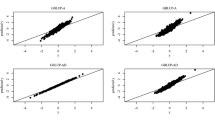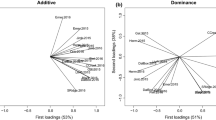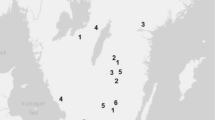Abstract
Key message
Modelling additive genotype-by-environment interaction is best achieved with the use of factor analytic models. With numerous environments and for outcrossing plant species, computation is facilitated using reduced animal models.
Abstract
The development of efficient plant breeding strategies requires a knowledge of the magnitude and structure of genotype-by-environment interaction. This information can be obtained from appropriate linear mixed model analyses of phenotypic data from multi-environment trials. The use of factor analytic models for genotype-by-environment effects is known to provide a reliable, parsimonious and holistic approach for obtaining estimates of genetic correlations between all pairs of trials. When breeding for outcrossing species the focus is on estimating additive genetic correlations and effects which is achieved by including pedigree information in the analysis. The use of factor analytic models in this setting may be computationally prohibitive when the number of environments is moderate to large. In this paper, we present an approach that uses an approximate reduced animal model to overcome the computational issues associated with factor analytic models for additive genotype-by-environment effects. The approach is illustrated using a Pinus radiata breeding dataset involving 77 trials, located in environments across New Zealand and south eastern Australia, and with pedigree information on 315,581 trees. Using this approach we demonstrate the existence of substantial additive genotype-by-environment interaction for the trait of stem diameter measured at breast height. This finding has potentially significant implications for both breeding and deployment strategies. Although our approach has been developed for forest tree breeding programmes, it is directly applicable for other outcrossing plant species, including sugarcane, maize and numerous horticultural crops.








Similar content being viewed by others
References
Apiolaza L (2012) Basic density of radiata pine in new zealand: genetic and environmental factors. Tree Genet Genomes 8:87–9
Bailey R (2008) Design of comparative experiments. Cambridge University Press, Cambridge
Baltunis B, Gapare W, Wu H (2010) Genetic parameters and genotype by environment interaction in radiata pine for growth and wood quality traits in australia. Silvae Genet 59:2–3
Beeck C, Cowling W, Smith A, Cullis B (2010) Analysis of yield and oil from a series of canola breeding trials. Part I: Fitting factor analytic models with pedigree information. Genome 53:992–1001
Burgueno J, Crossa J, Cotes J, Vincente F, Das B (2011) Prediction assessment of linear mixed models for multi-environment trials. Crop Sci 51:944–954
Butler DG, Cullis BR, Gilmour AR, Gogel BJ (2009) ASReml-R reference manual, release 3. Technical report, Queensland Department of Primary Industries
Costa e Silva J, Potts B, Dutkowski G, (2006) Genotype by environment interaction for growth of eucalyptus globulus in Australia. Tree Genet Genomes 2:61–75
Cullis B, Smith A, Beeck C, Cowling W (2010) Analysis of yield and oil from a series of canola breeding trials. Part II: Exploring VxE using factor analysis. Genome 53:1002–1016
Core Team R (2012) R: A language and environment for statistical computing. R Foundation for Statistical Computing, Vienna, Austria. ISBN 3-900051-07-0
Gilmour AR, Thompson R, Cullis BR (1995) AI, an efficient algorithm for REML estimation in linear mixed models. Biometrics 51:1440–1450
Gilmour AR, Cullis BR, Welham SJ, Gogel BJ, Thompson R (2004) An efficient computing strategy for prediction in mixed linear models. Comput Stat Data Anal 44:571–586
Hardner C, Dieters M, Dale G, DeLacy I, Basford K (2010) Patterns of genotype-by-environment interaction in diameter at breast height at age 3 for eucalypt hybrid clones grown for reafforestation of lands affected by salinity. Tree Genet Genomes 6:833–851
Henderson CR (1950) Estimation of genetic parameters (abstract). Ann Math Stat 21:309–310
Kelly A, Smith A, Eccleston J, Cullis B (2007) The accuracy of varietal selection using factor analytic models for multi-environment plant breeding trials. Crop Sci 47:1063–1070
Kelly AM, Cullis BR, Gilmour AR, Eccleston JA, Thompson R (2009) Estimation in a multiplicative mixed model involving a genetic relationship matrix. Genet Select Evol 41:1286–1297
Kempton RA (1984) The use of biplots in interpreting variety by environment interactions. J Agric Sci Camb 103:123–135
Oakey H, Verbyla A, Cullis B, Pitchford W, Kuchel H (2006) Joint modelling of additive and non-additive genetic line effects in single field trials. Theor Appl Genet 113:809–819
Oakey H, Verbyla A, Cullis B, Wei X, Pitchford W (2007) Joint modelling of additive and non-additive (genetic line) effects in multi-environment trials. Theor Appl Genet 114:1319–1332
Quass RL, Pollack E (1980) Mixed model methodology for farm and ranch beef cattle testing programs. J Animal Sci 51:1277–1287
Raymond C (2011) Genotype by environment interactions for pinus radiata in new south wales, australia. Tree Genet Genomes 7:819–833
Schutz W, Cockerham CC (1966) The effect of field blocking on gain from selection. Biometrics 22:843–863
Smith A, Cullis BR, Thompson R (2001) Analyzing variety by environment data using multiplicative mixed models and adjustments for spatial field trend. Biometrics 57:1138–1147
Stefanova K, Smith A, Cullis B (2009) Enhanced diagnostics for the spatial analysis of field trials. J Agric Biol Environ Stat 14:1–19
Thompson R, Cullis B, Smith A, Gilmour A (2003) A sparse implementation of the average information algorithm for factor analytic and reduced rank variance models. Aust N Z J Stat 45:445–459
White I, Rainer PR, Knap Brotherstone S (2006) Variance components for survival of piglets at farrowing using a reduced animal model. Genet Select Evol 38:359–370
Zapata-Valenzuela J (2012) Use of analytical factor structure to increase heritability of clonal progeny tests of pinus taeda l. Chil J Agric Res 72:309–315
Acknowledgments
Brian Cullis and Alison Smith gratefully acknowledge the financial support of the Grains Research and Development Corporation of Australia.
Conflict of interest
The authors declare that they have no conflict of interest.
Author information
Authors and Affiliations
Corresponding author
Additional information
Communicated by Jose Crossa.
Appendix
Appendix
Below is the ASReml-R syntax to fit the FA3 model. The ASReml-R function has numerous arguments which are described in detail in the user manual which is distributed with the package. The approach we use to fit an FA3 model is to use the REML estimates of the variance parameters from the FA2 model as starting values for the iterative fitting process for the FA3 model. We have found that this improves the chance of convergence without manual intervention. The first call to ASReml-R sets up a template which can then be populated with the appropriate starting values.
Note the formation of the design matrix for the additive effects of the parental and forward selection trees using the and constructor function.
The additional terms in the random model formula are terms which relate to the blocking structure of the trials. For example, the set of trials which were multi-tree plot trials is found in the data vector pplt, while the set of trials which were incomplete block designs is found in the data vector pblk. The relationship matrices for additive effects is provided in the ginverse argument, we require a very large amount of workspace and the term which is fitted as a sparse term is a factor with \(K\) levels where \(K\) is one more than the number of trees whose female parent was a control tree. Lastly the factor TExpt is a copy of the trial factor for those trials which are clonal trials else is it set to missing value indicator (NA).

Rights and permissions
About this article
Cite this article
Cullis, B.R., Jefferson, P., Thompson, R. et al. Factor analytic and reduced animal models for the investigation of additive genotype-by-environment interaction in outcrossing plant species with application to a Pinus radiata breeding programme. Theor Appl Genet 127, 2193–2210 (2014). https://doi.org/10.1007/s00122-014-2373-0
Received:
Accepted:
Published:
Issue Date:
DOI: https://doi.org/10.1007/s00122-014-2373-0




